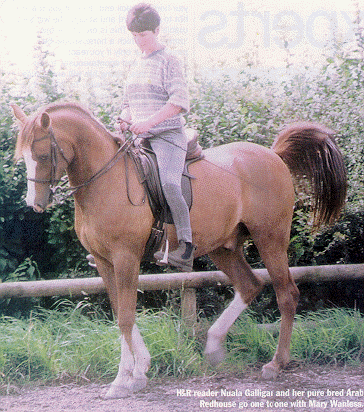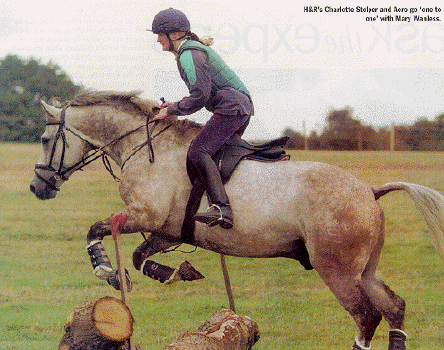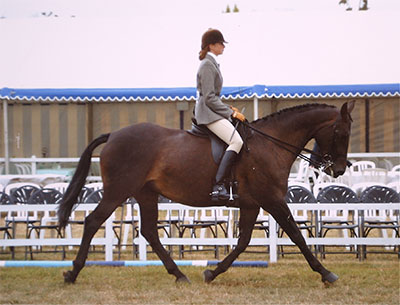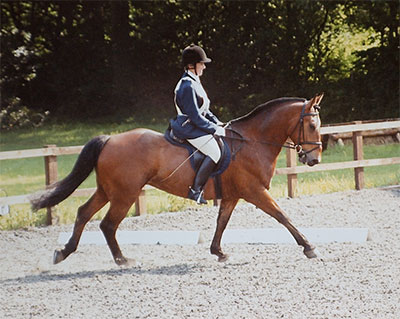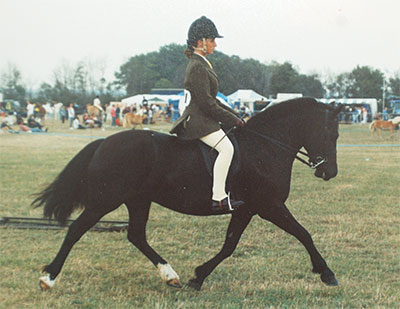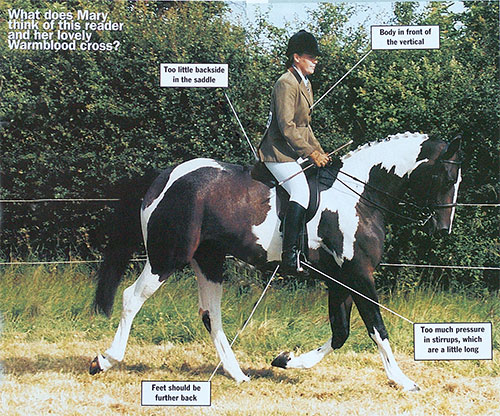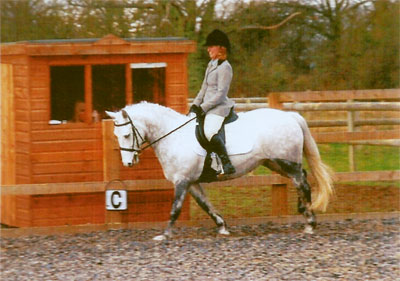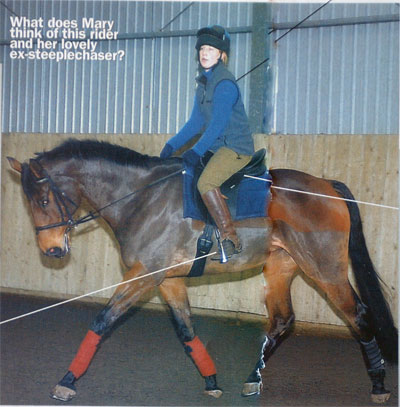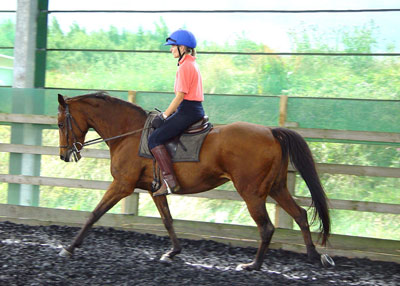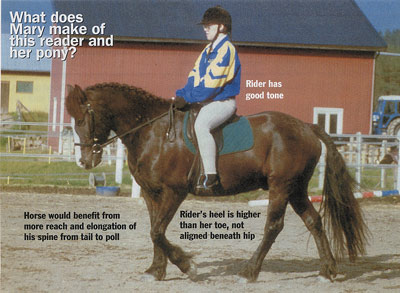RWYM
ARTICLE 40
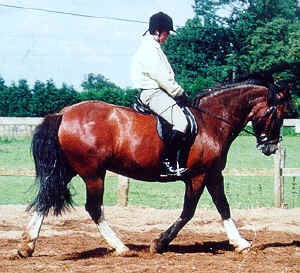 This photograph shows right rein trot, probably on a circle, and the rider is basically doing a good job. Her lovely cob (who looks a picture of health) might not have the quality to win an affiliated competition, but I suspect that she does very well at riding club level.
This photograph shows right rein trot, probably on a circle, and the rider is basically doing a good job. Her lovely cob (who looks a picture of health) might not have the quality to win an affiliated competition, but I suspect that she does very well at riding club level.
The changes which would improve this picture are really quite subtle, apart from the fact that the horse is not tracking up, and needs more impulsion. We can see that the hind foot has stepped onto the ground behind the hoof print left by the forefoot, and not into that hoof print. So he needs more activity. I suspect, however, that his trot may be more of a stepping gait than a jumping gait, lacking the period of suspension in which all four legs are off the ground. More impulsion would definitely help to enlarge this phase, although jumping from one diagonal pair of legs to the other does not come naturally to many horses of this type.
Whilst the horse’s natural paces (along with his laziness) might predispose him to this kind of movement, it is also possible that his rider is inhibiting him from using more energy. She is sitting to the trot, and when doing this it can be tempting to make the horse go slowly in order to make it easier for you! Most of us have fallen into that trap at some stage in our learning, and whilst some of us do it knowingly, others do it unknowingly.
When you first learn to sit (and whenever you revamp your sitting over the ensuing years), it can be important to go slowly, thereby giving yourself a trot which it is realistic for you to sit to. The horse then has to play the role of a “good donkey” whilst you get your act together – and then, when you go back to trot rising you have to send him strongly forward again, using the trot for his benefit rather than yours. Your aim is to gradually increase the amount of impulsion you can stay with, and to decrease the difference between the trot you have when you are rising and trot you have when you are sitting. Then you can confidently take your sitting trot into the competition arena. Some horses, however, refuse to play the “good donkey” role, and come up with so many evasions when asked to go slowly that the rider has no choice but to gird up her loins and learn to deal immediately with the more impulsive trot!
I doubt very much if this little guy is that type, and he probably expends his energy conservatively. So if his rider is content with a trot which would rate as a three out of ten on a scale which measures activity and commitment, I suspect that he is too – and he almost certainly works out his rider’s “bottom line” before she has even mounted! However, a six out of ten rider – or even an eight out of ten rider – would probably have very little trouble in motivating him to deliver six or eight out of ten….. as long as he knew that this really was her bottom line.
Our rider certainly does not look as if she is just cruising along trying to make things easy, and I think she is very committed. Her body has a nice tonal quality ie. she has quite a solid texture and instead of bouncing around like jelly she has the stability of putty. (We discussed this idea in the October article which featured a male rider who naturally has the high tone which most of us would die for.) This texture, along with the use of the abdominal muscles which I call bearing down is helping her to stay with the horse – albeit on this rather un-powerful trot.
Once you understand that the rider’s most important challenge is to match the forces which act on her body as result of the horse’s movement, you realise that there is more to riding than relaxing. The rider who cannot stay with the horse’s movement unwittingly ends up pulling back with her hand. The one who can is in fact generating forces within her body which act from the back towards the front. This means that she can ride along saying, “Look, no hands.”. This rider is certainly generating a push forward within her body which is stronger than the backward traction that she has on the reins, and she deserves our congratulations for this. However, I would like to see what would happen if we invited her to raise her hands a little and to push them forward.
I myself am not sure what would happen. I hope that the horse would keep this same head carriage, whilst possibly lengthening his neck a little. The fact that his neck makes such a nice even curve from the withers to the poll supports this view. But I have a suspicion that these very low hands may in fact have the function of holding his head down. If this is the case, then raising the hands and giving them forward would probably lead to the horse hollowing his back and bringing his nose up into the air.
The photograph gives the impression that there is more horse out behind the rider than there is in front of her, as if she is not quite sitting in the middle of him. This suggests that his neck should be longer in order to match his overall frame. Whilst one might argue that this picture is the inevitable result of a long backed conformation, even horses who are desperately out of proportion begin to defy their conformation and look like the archetypal dressage horse when they work correctly. So the rider could well be riding the horse more “from front to back” than from “back to front”. This view is also supported by the fact that he is a fraction overbent. The white blaze on his face makes this look more exaggerated than it actually is, and you may find it useful to place a pencil along the line of this nose. It will not quite be perpendicular to the line which joins his feet.
Having discussed the overall shape of the horse and the basic mechanics of sitting, we can now look in more detail at the rider. Her blouse disguises the line of her back, but if anything, I think she might be very slightly round backed. The forward inclination of her head supports this view. But the deviation from the ideal of “neutral spine” is very small. We see very clear creases in her breeches in the line where her thigh meets her backside, and this is a very good sign. In fact, she has a nice “square bum” – which is the result of how she is organising her pelvis on the saddle, and not of innate slimness! This is an enviable quality which men show much more easily than women. (Again, see the October article.) It took me years work out how to turn my naturally rather round backside into a square one!
However, our rider would not quite land on the riding arena on her feet if we took her horse out from under her by magic, as her heel is a little too down and forward. This means that her centre of gravity is slightly behind her base of support, and as a result, she is likely to be squashing the horse’s back down slightly. Her thigh lies at an angle which is less than 45 degrees to the ground, and I consider 45 degrees to be the optimum angle as it gives the thigh maximum leverage. Many trainers would insist that the thigh should be more vertical, and this is an argument I will expand on when we look at next month’s photograph, explaining how using the thigh as a lever helps the rider to lift the horse’s back.
Suffice it to say right now that I would rather see the rider’s leg looking too short than too long, and in fact, she probably does not need to lengthen her stirrups. She just needs to move her knee back and down by about an inch, and through doing this to bring her foot more back underneath her. This will bring her knee back away from the knee roll, and she will then have to avoid the “homing instinct” which will draw it back up there again!
It may be helpful for the rider to imagine that there is a little hook attached to the boney knobble on the inside of each knee, and that this hook fixes both of them to the ends of a bar which passes though the horse’s barrel. Note that the bar is not elastic, so it does not to pull her knees into the saddle; it just holds them in place – further down and further back than it is easy to have them. Sometimes the knee is not actually on the saddle when it is in the ideal position – this depends entirely on the design of the saddle and on how well it fits the rider – but I think this rider’s knees will still lie on it.
So I am pleased to be able to tell this rider that she is doing a lot right, and has a lot going for her. My major recommendations are that she lifts her hands and carries them wider apart, knowing that the horse’s response to this will serve as a test for the genuiness of his carriage. Also, that she brings her knee and lower leg a little further back, and learns how this can help her generate the leverage which will lift his back more effectively. This in turn will help her feel secure in the fact that his head and neck do not need to be held in place with her hand. For when his back is held in place by her body, his head and neck take care of themselves, reaching and arching into the rein just like it says they should in the text books.


